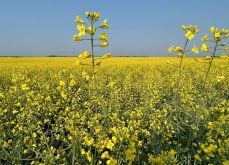If you see Dave Krindle sliding around on the banks of a local stream, or climbing around the edges of a mine’s tailings piles or mired deep in the mud on the edges of the Red River in Winnipeg, he isn’t up to anything nefarious.
He’s looking for soil for that next great glaze.
Life would be easier for him if he bought his materials off the professional potter’s stock list, but for him, making art out of the prairie soils is both an artistic passion and a personal commitment.
Read Also

StatCan stands by its model-based crop forecast
Statistics Canada’s model-based production estimates are under scrutiny, but agency says it is confident in the results.
“We tend to import a great deal of our minerals now for pottery, simply because we haven’t been here very long,” said Krindle in an interview at Winnipeg’s Stoneware Gallery, a cooperative venture.
“We haven’t discovered (how to use local prairie materials) and it’s more work. It’s like growing your own garden instead of going to the supermarket. It’s more work, but if you love it, it’s much more rewarding.”
Krindle tries to use local clays wherever he can. Almost all prairie pottery is made from clay from either the Medicine Hat area of Alberta or from Stratford, Ont.
It might seem odd to prairie farmers, who are often beset by the problems of thick clay in their fields, that clay has to be imported from hundreds of kilometres away. Clay is a compound of hundreds of substances and the wrong ones can make them impossible for pottery.
That’s the situation with Manitoba clays, which were mostly produced under and around the ancient Lake Agassiz and contain large amounts of calcium from ancient shells. That means they liquefy when put in kilns, which makes them unsuitable for most types of pottery.
But they can form the base for glazes, which is how Krindle uses them.
Krindle waits until the Red River drops low in the late fall, then climbs down to the water’s edge and digs in to find deposited clay.
He takes the clay back to his studio, kills the microbes by heating it, pulverizes it, adds a bit of feldspar for body, and then uses it to make a dark glaze.
By itself, the clay would form a dark brown glaze, but because people won’t buy dark brown pottery – potter call the colour “hang-around-brown” – he adds a little black and comes out with a rich, deep, black glaze.
Krindle said it’s unique, and that’s what he wants. He believes local materials can be used to create arresting visual impacts.
“You can get beautiful, striking, elegant effects from mainly coarse and simple materials,” he said.
“They don’t have to look crude. I’m not out to make stuff that looks deliberately crude. I make stuff as elegant as I can using natural materials.” Because people and potters have been on the Prairies for a relatively short time, neither a comprehensive inventory of usable materials nor a recipe book for how to use local materials exists. But Krindle thinks artists like him will be able to develop those.
“It may take centuries, but that’s what’s happened in the rest of the world,” said Krindle. “It’s more like cooking than chemistry. You don’t need to know what’s happening (chemically) when you fry something, but you can judge it by its taste.”

















